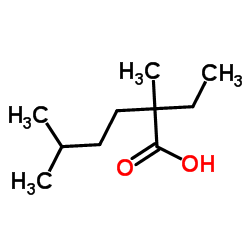26896-20-8
| Name | Neodecanoic acid |
|---|---|
| Synonyms |
New decanoate
VERSATIC 10 ACID 2-Ethyl-2,5-dimethylhexanoic acid EINECS 248-093-9 Neodecansure NEO-DECANOIC ACID Wiltz-65 Neododecanoic acid Topper 5E neo-decanoic MFCD00068291 |
| Density | 0.9±0.1 g/cm3 |
|---|---|
| Boiling Point | 262.1±8.0 °C at 760 mmHg |
| Melting Point | 34-36 °C(lit.) |
| Molecular Formula | C10H20O2 |
| Molecular Weight | 172.265 |
| Flash Point | 118.6±9.8 °C |
| Exact Mass | 172.146332 |
| PSA | 37.30000 |
| LogP | 3.42 |
| Vapour Pressure | 0.0±1.1 mmHg at 25°C |
| Index of Refraction | 1.441 |
|
Section 1: Product Identification Chemical Name:neo-Decanoic acid, prime grade CAS Registry Number:26896-20-8 Formula:isomeric C10 acids EINECS Number:248-093-9 Chemical Family:Aliphatic carboxylic acid Synonym:Neodecanoic acid
Section 2: Composition and Information on Ingredients IngredientCAS NumberPercentACGIH (TWA)OSHA (PEL) Title Compound26896-20-8100%no datano data Section 3: Hazards Identification Emergency Overview:Irritating to skin, eyes and respiratory tract. Primary Routes of Exposure:Ingestion, inhalation, skin, eyes Eye Contact:Causes moderate irritation to the eyes. Skin Contact:Causes moderate irritation to the skin. Inhalation:Causes mild irritation to the nose, mucous membranes, and respiratory tract. Ingestion:No specific information is available on the physiological effects of ingestion. Acute Health Affects:Irritating to skin, eyes, and respiratory tract. Chronic Health Affects:No information available on long-term chronic effects. NTP:No IARC:No OSHA:No SECTION 4: First Aid Measures Immediately flush the eyes with copious amounts of water for at least 10-15 minutes. A victim may need Eye Exposure: assistance in keeping their eye lids open. Get immediate medical attention. Wash the affected area with water. Remove contaminated clothes if necessary. Seek medical assistance if Skin Exposure: irritation persists. Remove the victim to fresh air. Closely monitor the victim for signs of respiratory problems, such as difficulty Inhalation: in breathing, coughing, wheezing, or pain. In such cases seek immediate medical assistance. Seek medical attention immediately. Keep the victim calm. Give the victim water (only if conscious). Induce Ingestion: vomiting only if directed by medical personnel. SECTION 5: Fire Fighting Measures Flash Point:not applicable Autoignition Temperature:no data Explosion Limits:no data Extinguishing Medium:dry chemical, carbon dioxide, water, or foam. Fire fighters should be equipped with a NIOSH approved positive pressure self-contained breathing apparatus Special Fire Fighting Procedures: and full protective clothing. Hazardous Combustion andIf involved in a fire this material may emit toxic organic fumes, carbon monoxide, and carbon dioxide. Decomposion Products: Unusual Fire or Explosion Hazards: No unusual fire or explosion hazards. SECTION 6: Accidental Release Measures Small spills can be mixed with vermiculite, sodium carbonate or other suitable non combustible adsorbent and Spill and Leak Procedures: swept up. SECTION 7: Handling and Storage Handling and Storage:No special precautions needed in handling and storage. SECTION 8: Exposure Controls and Personal Protection Eye Protection:Always wear approved safety glasses when handling a chemical substance in the laboratory. Skin Protection:Wear protective clothing and gloves. Consult with glove manufacturer to determine the proper type of glove. Ventilation:If possible, handle the material in an efficient fume hood. If ventilation is not available a respirator should be worn. The use of respirators requires a Respirator Respirator: Protection Program to be in compliance with 29 CFR 1910.134. Ventilation:If possible, handle the material in an efficient fume hood. Additional Protection:No additional protection required. SECTION 9: Physical and Chemical Properties Color and Form:colorless liq. Molecular Weight:not applicable Melting Point:no data Boiling Point:243-253° Vapor Pressure:no data Specific Gravity:no data Odor:none Solubility in Water:insoluble SECTION 10: Stability and Reactivity Stability:air and moisture stable Hazardous Polymerization:no hazardous polymerization Conditions to Avoid:none Incompatibility:active metals Decomposition Products:carbon monoxide, carbon dioxide, and organic fumes. SECTION 11: Toxicological Information Oral(rat); LD50: 2000mg/kg. Administration onto skin(rabbit); LD50: >3160mg/kg. Inhalation(rat); LC50: RTECS Data: >3000mg/m3/6H. Inhalation(mouse); LC50: >3000mg/m3/6H. Carcinogenic Effects:No data available Mutagenic Effects:No data available Tetratogenic Effects:No data available SECTION 12: Ecological Information Ecological Information:No information available SECTION 13: Disposal Considerations Disposal:Dispose of according to federal, state, and local regulations. SECTION 14: Transportation Shipping Name (CFR):Non-hazardous Hazard Class (CFR):NA Additional Hazard Class (CFR):NA Packaging Group (CFR):NA UN ID Number (CFR):NA Shipping Name (IATA):Non-hazardous Hazard Class (IATA):NA Additional Hazard Class (IATA):NA Packaging Group (IATA):NA UN ID Number (IATA):NA SECTION 15: Regulatory Information TSCA:Listed in the TSCA inventory. SARA (Title 313):Title compound not listed. Second Ingredient:none SECTION 16 - ADDITIONAL INFORMATION N/A |
| Hazard Codes | C |
|---|---|
| Risk Phrases | R36/37/38 |
| Safety Phrases | S26-S36/37/39 |
| RIDADR | 3265.0 |
| HS Code | 2915900090 |
| HS Code | 2915900090 |
|---|---|
| Summary | 2915900090 other saturated acyclic monocarboxylic acids and their anhydrides, halides, peroxides and peroxyacids; their halogenated, sulphonated, nitrated or nitrosated derivatives VAT:17.0% Tax rebate rate:9.0% Supervision conditions:AB(certificate of inspection for goods inward,certificate of inspection for goods outward) MFN tariff:5.5% General tariff:30.0% |

